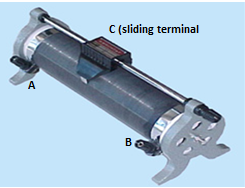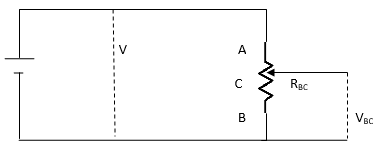Question 5: Explain the construction of rheostat. How is it used as (a) control the current (b) as potential divider?
ANSWER
A special type of resistance wire wrapped around an insulating core is called a wire-wound resistor. As resistance of a resistor is directly proportional to the length and resistivity of the wire, a suitable wire (like Manganin) of suitable length can be used for this purpose. Tungsten, Constantan and Eureka are other alloys used for this purpose.

A variable wire-wound resistor consists of a bare maganin wire, wound on an insulating cylinder. The ends of the wire are connected to fixed terminal A and B. A third terminal C is attached to a sliding contact, which can be moved over the wire. Such resistors may be used as Rheostat or Potential dividers.
Rheostat as current control
It makes use of the variable resistor as a current control device. The resistance depends upon the length of the resistor. The sliding terminal C provides a variable length of the resistor and hence a variable resistance when inserted in the circuit. When the C is slid toward A, the length is decreased and the resistance is also decreased. Similarly, moving it away from the terminal A, making use of more length and hence the resistance also increases. In this way the current is controlled in the circuit
Rheostat as Potential Divider
A potential divider is used for getting a variable potential from a fixed potential difference. A potential difference V is provided with the help of a battery across the ends of a variable resistor. If R is the resistance of the wire, the current flowing in the resistor is
I = V/R.

Let RBC be the resistance of the portion BC of the wire. The current passing through this portion is also I. The PD between the points B and C is given by VBC =I RBC

RBC increases as we go away from A and decreases as C comes close to A. This changes the ratio RBC to R and hence a variable voltage can be obtained. If V is regarded as input PD to the potential divider and VBC as the output PD, then VBC can be tapped off and applied to another circuit.

Pingback:wheatsone-bridge-its-principle-and-balancing – msa
Pingback:emf-internal-resistance-terminal-potential – msa
Pingback:Comprehensive Questions, Current Electricity … msa – msa